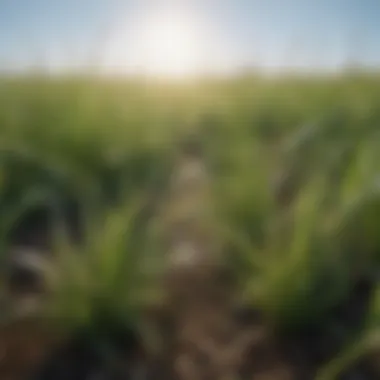Optimal Watering Schedule for Healthy Lawns


Intro
Establishing a prudent watering schedule is crucial for the vitality of lawns. Understanding how much and when to water can profoundly affect grass health, soil quality, and the ecosystem. Effective watering practices not only foster lushness but also promote sustainable water use in various climates.
In this section, we will analyze vital research and present comprehensive insights on developing an appropriate watering routine tailored to specific grass types and environmental conditions.
Research and Data Analysis
Latest Trends in Agriculture and Horticulture
The landscape of agriculture and horticulture is shifting towards more sustainable practices. New advancements in irrigation technology include smart systems that use sensors to measure soil moisture levels. These systems can adjust watering schedules based on current weather conditions, significantly decreasing water waste.
Several studies indicate a transition towards drought-resistant grass varieties. These types require less water and are more adaptable to changing climatic conditions. With a focus on sustainability, researchers are finding innovative ways to blend traditional watering methods with emerging technology to optimize lawn health while conserving resources.
Statistical Insights into Crop Yields
Data from agricultural studies reflect that regions implementing an optimized watering schedule see an increase in crop yields by up to 30%. For homeowners, this translates into a greener lawn that requires less intervention. An understanding of local rainfall patterns, soil types, and grass species is paramount for designing an effective watering schedule.
Moreover, research indicates that lawns receive the greatest benefits when watered during cooler parts of the day. This minimizes evaporation and allows water to penetrate the soil more effectively, ensuring grasses are adequately hydrated.
Best Practices and Techniques
Efficient Lawn Watering Strategies
To achieve optimal results, a few best practices stand out for watering lawns effectively:
- Timing: Water early in the morning or late in the evening when the air temperature is cooler. This ensures more water reaches the roots.
- Frequency: Generally, lawns need about one to one and a half inches of water per week, either through rainfall or irrigation.
- Measurement: Use a rain gauge or container to measure how much water your sprinkler is applying.
Sustainable Horticultural Techniques
Employing sustainable techniques can boost lawn health while preserving the environment. Some methods include:
- Soil Aeration: This allows water to penetrate deeper and promotes healthy root growth.
- Mulching: Applying mulch retains moisture and helps regulate soil temperature.
- Native Grasses: Consider planting native grass species that require less water and maintenance. Such grasses are often more resilient and better for the local ecosystem.
Pest and Disease Management
Common Pests and Diseases in Lawns
Understanding potential threats to lawn health is key. Common challenges include:
- Grubs: These pests feed on grass roots and can cause brown patches.
- Rust: Fungal diseases that can weaken grass and lead to discoloration.
- Dollar Spot: A common issue that appears as small, bleached patches in the lawn.
Integrated Pest Management Strategies
Managing these issues effectively can include the use of beneficial insects, regular monitoring, and appointing resistant grass varieties. This minimized approach ensures that the lawn remains healthy without excessive chemical interventions.
By understanding the fundamental aspects of watering, readers can establish a regimen suited to their lawn's specific needs. This knowledge not only promotes a more vibrant lawn but also aligns with responsible water usage practices that benefit the community and environment.
Understanding Lawn Hydration
Proper lawn hydration is crucial for maintaining the vibrancy and health of grass. Water acts as a necessary resource for photosynthesis, nutrient uptake, and overall growth. An understanding of how hydration works is essential for establishing an effective watering schedule.
The Importance of Water for Grass Health
Water is a fundamental component of grass health, influencing not only its appearance but also its resilience against pests and diseases. Grass, like all plants, relies on water for various physiological functions. It facilitates nutrient transport from the soil to the plant, allowing grass to flourish and develop deeper root systems. This results in a more robust lawn that can better withstand drought conditions.
To ensure grass remains healthy, it requires consistent moisture. Insufficient watering can lead to stress, causing brown patches and weakened growth. Too much water, conversely, can create saturation, resulting in root rot and other issues. Finding the balance is key.
How Watering Affects Growth


Watering frequency and amount directly impact grass growth. When grass receives the right amount of water at the right times, it thrives. Inadequate watering can stunt growth and lead to shallow root development. This makes lawns more vulnerable during dry periods. Conversely, regular and deep watering encourages roots to grow downwards, promoting stronger and healthier plants.
Furthermore, the timing of watering can influence growth patterns. Early morning watering allows grass to absorb moisture while minimizing evaporation. Evening watering can leave grass wet overnight, increasing the risk of diseases. Understanding these dynamics helps in crafting an appropriate watering schedule that promotes vigorous growth and prevents common lawn problems.
Factors Influencing Watering Needs
Understanding the factors that influence the watering needs of your lawn is crucial for effective irrigation. These elements not only affect how much water your grass requires but also directly impact its overall health and appearance. A tailored watering regimen can enhance the resilience of your lawn while ensuring efficient water use. Let's explore the key considerations.
Soil Type and Its Impact
Soil type plays a significant role in how water is retained and drained. Different soils have varying compositions that can affect moisture levels. For instance, sandy soils drain quickly, requiring more frequent watering, while clay soils retain water longer but may become compacted.
- Sandy Soil: Drains rapidly; requires more frequent watering.
- Clay Soil: Retains water; may need less frequent watering. Compaction in clay can lead to poor water absorption.
- Loamy Soil: A balanced mixture; tends to retain moisture effectively, making it ideal for lawns.
When developing a watering schedule, it's essential to consider your soil type. Conduct soil tests to determine the composition and adjust your watering strategy accordingly. This will help avoid both overwatering and underwatering, each of which can stress the grass.
Climate Conditions Overview
Climate conditions are another critical factor that dictates watering needs. The amount of rainfall, temperature fluctuations, and humidity levels directly affect how much supplemental watering your lawn requires.
In drier climates, more frequent watering is necessary compared to regions with a higher rainfall average. Additionally, temperature matters.
- Hot Conditions: Grass uses more water; consider increasing the frequency.
- Cooler Temperatures: Grass needs less water; reduce the watering regimen.
Monitoring local weather patterns can guide your irrigation decisions. Be mindful of seasonal changes, as they can shift watering needs significantly.
Grass Variety Considerations
Different grass varieties have unique water requirements. Understanding the specific needs of the grasses in your lawn can lead to more efficient watering practices. Some types can tolerate drought better than others.
- Warm-Season Grasses: Thrive in higher temperatures and require more water in summer months. Examples include Bermuda and Zoysia.
- Cool-Season Grasses: Prefer cooler conditions and need adequate moisture during early spring or fall. Examples are Kentucky Bluegrass and Fescue.
Choosing the right grass variety for your region will impact your lawn's watering schedule. It is advisable to research grass varieties suitable for your local climate to ensure a healthy lawn with minimal maintenance.
"Understanding the interplay of soil type, climate, and grass variety is essential for establishing an efficient watering routine that promotes a healthy lawn."
By considering these factors, you will develop a more effective approach to lawn care that not only enhances grass health but also fosters responsible water usage.
Creating a Watering Schedule
Creating a watering schedule is a critical step for ensuring optimal hydration of your lawn. A well-structured schedule allows water to penetrate the soil effectively, promoting deep root growth and overall grass health. It also minimizes resource wastage, which is essential in drought-prone areas. Understanding your lawn's specific requirements can result in lush, green grass while conserving water.
Assessing Your Lawn's Needs
Assessing your lawn's needs starts with understanding its unique conditions. Different factors affect how much water is necessary. First, consider the soil type. Sandy soils drain quickly, requiring more frequent watering, while clay retains moisture longer. Conducting a soil test might also be useful to know the pH levels and nutrient content.
Next, consider your grass variety. Kentucky bluegrass, for example, will have different watering requirements than Bermuda grass. Ensuring you know the specific needs of your grass type involves research and observation.
Also, observe visual cues such as grass color and texture. If your lawn appears dull or has footprints that remain visible, it could signal a lack of water. Conversely, if there is a lot of thatch or moss, this can indicate overwatering.
Timing: Early Morning vs. Evening
Timing your watering is equally as important as determining the amount. Watering early in the morning is generally recommended. During this time, temperatures are cooler, and winds are calmer, which reduces evaporation and allows for deeper moisture absorption.
In contrast, evening watering can lead to prolonged moisture on the grass, creating an environment for fungi and disease to thrive. If you choose to water in the evening, be mindful of air circulation.
To sum it up, early morning watering helps the grass prepare for the day while evening watering should be minimized to reduce disease risk.
Frequency: Optimizing Watering Days
Finding the right frequency is vital for lawn health. Generally, lawns benefit from about one to one and half inches of water each week, whether applied in one deep watering session or divided into two lighter sessions.


Some factors to consider when optimizing watering frequency include:
- Weather patterns: Adjust your watering schedule based on rainfall. If it's been rainy, reduce your watering days.
- Seasonal variations: Lawns typically need more water during the hot months and less during cooler seasons.
- Grass growth cycles: Newly planted grass or sod may need more frequent watering initially.
By adjusting the frequency as needed, you can maintain a healthy lawn while being thoughtful about water use.
Water Application Techniques
Water application techniques play a critical role in the overall health and efficiency of lawn watering. The method chosen can significantly impact water penetration, distribution, and evaporation rates. Understanding these techniques ensures that grass receives adequate moisture, fostering land vitality without leading to waste. This allows homeowners and gardeners to create lush, green lawns while being mindful of essential water conservation practices.
Methods of Watering: Sprinklers vs. Soakers
When it comes to watering techniques, sprinklers and soakers serve as two prominent options with unique advantages.
Sprinklers are commonly used to uniformly distribute water over a wide area. Traditional sprinklers can be adjusted for spray patterns, covering specific regions without much hassle. They are suitable for large lawns and can provide a nice rain-like effect. However, there are drawbacks. Sprinklers may lead to water loss through evaporation, especially in hot or windy conditions. Furthermore, excess water can pool, causing runoff instead of groundwater absorption.
On the other hand, soaker hoses offer a gentler approach to watering. These hoses seep water slowly into the soil, providing consistent moisture directly to the roots. This method reduces evaporation losses and minimizes water runoff. Soakers work exceptionally well for garden beds or narrow areas where more targeted watering is needed. While they may require more initial setup and planning, the benefits for water efficiency and soil hydration can be substantial.
Measuring Water Depth: How Much Is Enough
Determining how much water your lawn needs is non-negotiable for effective irrigation. The general guideline for healthy grass is to apply about one to one and a half inches of water each week. To measure water depth accurately, several tools are available.
- A simple rain gauge can be placed in the yard to catch water and gauge how much has fallen during watering.
- Alternatively, placing a few empty tuna cans around the yard can provide a rudimentary method to measure cumulative rainfall or sprinkler output.
It's essential to monitor the depth regularly. Check the readings after watering to confirm that the desired amount is being achieved. If you notice less than one inch, your watering practices may need adjustment.
Furthermore, regular assessments allow you to adjust for changing conditions, such as temperature and humidity, which can impact the water requirements of the grass.
Consistency in measuring water depth helps ensure the lawn gets what it needs for optimum health without over-watering.
By applying right techniques and accurate measurements, you can maintain a healthy lawn that thrives while promoting sustainable water use.
Common Mistakes to Avoid
Effective lawn watering requires more than just turning on a hose. Understanding common watering mistakes can greatly enhance the health of a lawn. This section addresses two prevalent pitfalls: overwatering and ignoring seasonal changes. Acknowledging these mistakes ensures better grass management, aids in water conservation, and promotes a sustainable approach to lawn care.
Overwatering: Signs and Solutions
Overwatering is a frequent error for many lawn caretakers. When grass receives too much water, several adverse effects can occur. One such effect is root rot, which can lead to a troubled grass root system, making it unsustainable in the long term. Symptoms of overwatering include yellowing blades and a spongy feel to the soil.
To combat this issue, observe the following signs:
- Yellow patches in your lawn.
- Excessively wet soil that does not drain.
- Fungus or mold growth on the grass or soil surface.
Solutions include more vigilant monitoring of the watering schedule. Implement a rain gauge to gauge the amount of water applied. Additionally, consider adjusting your schedule based on rainfall and temperature changes. Aim for about one inch of water per week, including rain. This will help avoid the dangers of overwatering while maintaining healthy grass growth.
Ignoring Seasonal Changes
Ignoring seasonal changes is another significant mistake in lawn care. Grass has distinct watering needs throughout the year. A misunderstanding of these needs could result in inadequate watering or excessive watering, both of which harm lawn health.
For example, in the spring, when temperatures begin to rise, lawns often require more water as they enter their growth phase. Conversely, during summer months, there might be increased evaporation, necessitating more frequent watering.
During fall, it's essential to reduce watering as the grass enters dormancy. Winter, in most climates, usually demands no watering at all, as the grass will rely on precipitation and snow melt.
Therefore, take note of seasonal temperatures and adjust your watering schedule accordingly:
- Annotate changes in water needs for spring, summer, fall, and winter.
- Observe local weather patterns and adjust watering days based on rainfall.
"Monitoring seasonal changes leads to a healthier, more resilient lawn."


Sustainability in Lawn Watering
Sustainability in lawn watering is a pivotal component of effective water management. It entails strategies that conserve water while maintaining a healthy lawn. In an era of climate change and increasing water scarcity, understanding sustainable watering practices becomes essential. The particular benefits of these practices include reduced water consumption, lower utility bills, and a healthier ecosystem.
When adopting a sustainable approach, one must consider the local environment. Implementing methods that align with the natural climate and soil can make a significant difference. This involves selecting suitable grass varieties and techniques that minimize water wastage.
Choosing Native Grass Varieties
Selecting native grass varieties is a critical part of creating a sustainable lawn. Native grasses are better adapted to local climate conditions, which means they usually require less water. They have deep root systems that penetrate the soil, allowing them to access moisture more efficiently than non-native species.
In addition, native grasses typically resist pests and diseases better, leading to healthier lawns with less reliance on chemical pesticides or fertilizers. This reduces not only the environmental impact but also the costs associated with lawn care. Homeowners should look into species such as Buffalo grass or Blue grama, which perform well in various conditions with minimal water.
The choice of grass directly impacts the lawn's overall water needs and resilience. Choosing wisely from the start sets the stage for a sustainable landscape.
Implementing Rainwater Harvesting
Implementing rainwater harvesting is another effective strategy that enhances sustainability in lawn watering. This practice involves collecting and storing rainwater for later use. The collected water can be utilized to irrigate lawns, gardens, or even indoor plants, helping to decrease reliance on municipal water systems.
Setting up a rainwater harvesting system can be relatively simple. Homeowners can install rain barrels under downspouts to collect runoff from roofs. The stored water can then be transferred to watering devices or gardens as needed. This not only conserves water but also reduces stormwater runoff, which can lead to erosion and water pollution.
In summary, embracing sustainability in lawn watering through the choice of native grass and rainwater harvesting contributes positively to both the environment and individual lawn health. The simple act of making informed choices can result in significant long-term benefits.
Technology and Innovation in Irrigation
In recent years, advancements in technology have greatly influenced irrigation practices. The integration of modern irrigation methods can optimize water usage, enhance grass health, and reduce labor costs. Embracing innovation in irrigation is essential for achieving a lush green lawn while being responsive to environmental challenges and water conservation efforts.
Smart Irrigation Systems
Smart irrigation systems represent a significant leap forward in the way we manage lawn hydration. These systems utilize automation and connectivity to provide precise watering based on real-time conditions. They often incorporate schedules that adjust according to weather patterns, evaporation rates, and soil moisture levels.
Benefits of smart irrigation systems:
- Efficiency: They minimize water waste by delivering the right amount of water at the right times.
- Convenience: Programmable features allow homeowners to set schedules and forget about manual watering.
- Cost-Effective: Reducing unnecessary water usage can lead to decreased utility bills over time.
Incorporating smart technology not only supports sustainable practices but also assists in maintaining a robust lawn even in varying climactic conditions.
Soil Moisture Sensors
Soil moisture sensors are essential tools that monitor the moisture levels in the soil. These devices assess the current state of hydration, informing homeowners when watering is needed. They contribute to informed decision-making when it comes to irrigation.
Key aspects of soil moisture sensors include:
- Data-Driven: Providing real-time feedback means more informed watering decisions.
- Targeted Irrigation: They ensure that water is applied where and when it is truly needed, preventing both over and under-watering.
- Environmental Benefits: By optimizing water use, these sensors help preserve resources and support local ecosystems.
"Utilizing soil moisture sensors can transform your lawn care routine, leading to healthier grass while conserving precious water resources."
Adjustment and Adaptation
Adjustment and adaptation in lawn watering practices are essential for maintaining a healthy and vibrant lawn. This section emphasizes the necessity of tailoring your watering strategy based on ongoing assessments. Regular monitoring of your lawn's condition and environmental factors can lead to more efficient water usage and better grass health.
Monitoring Lawn Health
Monitoring lawn health goes beyond mere observation. It involves actively assessing the condition of the grass, soil, and overall environment. Look for indicators such as color, texture, and growth patterns. A healthier lawn exhibits a rich green color, while yellowing may suggest a need for water.
Develop a straightforward system to check soil moisture. An effective way to do this is to use a moisture meter or simply stick your finger into the soil. If the top inch feels dry, it is a sign that watering is necessary. Observing changes in leaf blade appearance can also indicate hydration levels. For example, wilting or curling leaves often point to insufficient moisture.
In addition, keep an eye on weather conditions. Rainfall, humidity, and temperature fluctuations greatly affect watering requirements. Staying informed will help you adjust your schedule accordingly, avoiding overwatering or underwatering altogether.
Seasonal Adjustments to Watering Strategy
Every season brings distinct environmental shifts that impact your lawn's watering needs. As spring transitions into summer, grass usually requires more water due to the increased heat and evaporation rates. Conversely, during the fall and winter months, a reduced watering frequency is often needed.
Here are some key considerations for seasonal adjustments:
- Spring: As temperatures rise, consistently monitor soil moisture. Gradually increase the frequency of your watering to support growth.
- Summer: High heat may require daily watering, especially for more sensitive grass types. However, ensure early morning watering to minimize evaporation.
- Fall: As grasses enter dormancy, reduce watering frequency. Lawns usually need less water, but ensure they remain hydrated enough to survive the transition.
- Winter: In many regions, grass enters a dormant phase, requiring little to no watering. However, if there are dry periods, a brief watering session may be necessary to protect the roots.
By employing a proactive approach in adjusting your watering strategy according to seasonal changes, you can maintain lawn health, conserve water, and create a more sustainable environment.















